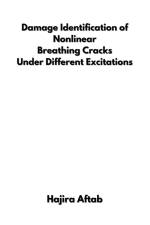von Hajira Aftab
30,00 €
Explore the intricate world of structural integrity in "Damage Identification of Nonlinear Breathing Cracks Under Different Excitations" by Hajira Aftab. Delve into the challenges faced by industrial robots, spaceships, aircraft, submarines, bridges, and pressure vessels as they encounter diverse loading conditions. These complex structures, susceptible to damage from fatigue and aging, hide small yet potentially fatal breathing cracks that exhibit non-linear behavior.While various nonlinear techniques have been developed for detecting and localizing breathing cracks in one-dimensional structures like beams, the realm of plate-like (2D) structures poses a greater challenge. Aftab takes you on a journey through her research, where she presents a groundbreaking mathematical model of a breathing part-through crack in a plate, based on piecewise equations. The cracked plate is ingeniously portrayed as a bilinear oscillator, revealing two frequencies corresponding to distinct stiffness regions that signify the breathing phenomenon.The method of multiple scales is skillfully employed to uncover the solution of the cracked plate, utilizing different excitations and enhancing the understanding of breathing crack frequency. Aftab validates her findings through a meticulous approach, incorporating mathematical equations, numerical simulations, and experimental work. To identify breathing cracks, she introduces the application of the Hilbert transform on 2D structures, detecting cracks by analyzing the plate's response.Aftab's research explores the significance of excitation signals, demonstrating that impulse excitation excels in identification, while harmonic excitation provides accurate severity estimation. Even random excitations are harnessed to evaluate their potential in achieving superior results for crack identification and severity assessment.A pivotal discovery in Aftab's work is the correlation between the instantaneous frequency obtained and the severity estimation of breathing cracks. The presented research harnesses the attributes of various excitation signals, enhancing both detection and severity estimation techniques. Remarkably, Aftab's method does not rely on baseline data for the identification of breathing cracks, establishing it as a baseline-free approach."Disease Identification of Nonlinear Breathing Cracks Under Different Excitations" offers a comprehensive exploration of the complexities involved in identifying and understanding breathing cracks in diverse structures. Aftab's groundbreaking research promises to reshape our approach to structural integrity, making it a must-read for researchers, engineers, and enthusiasts alike.

